from pastelegram.org, June 2011 – April 2014
Feel the Moon
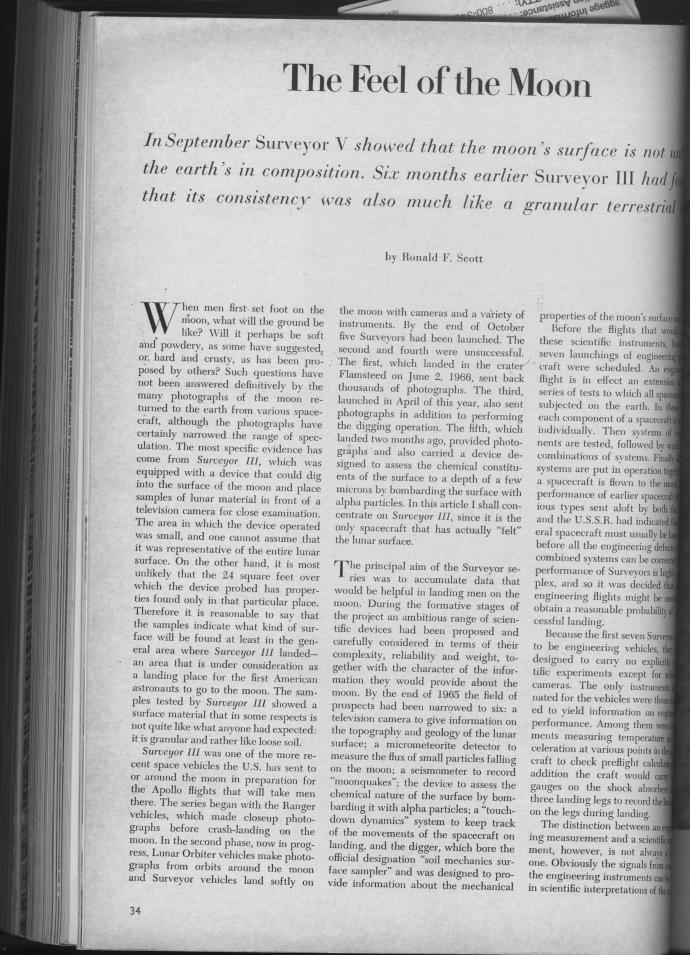
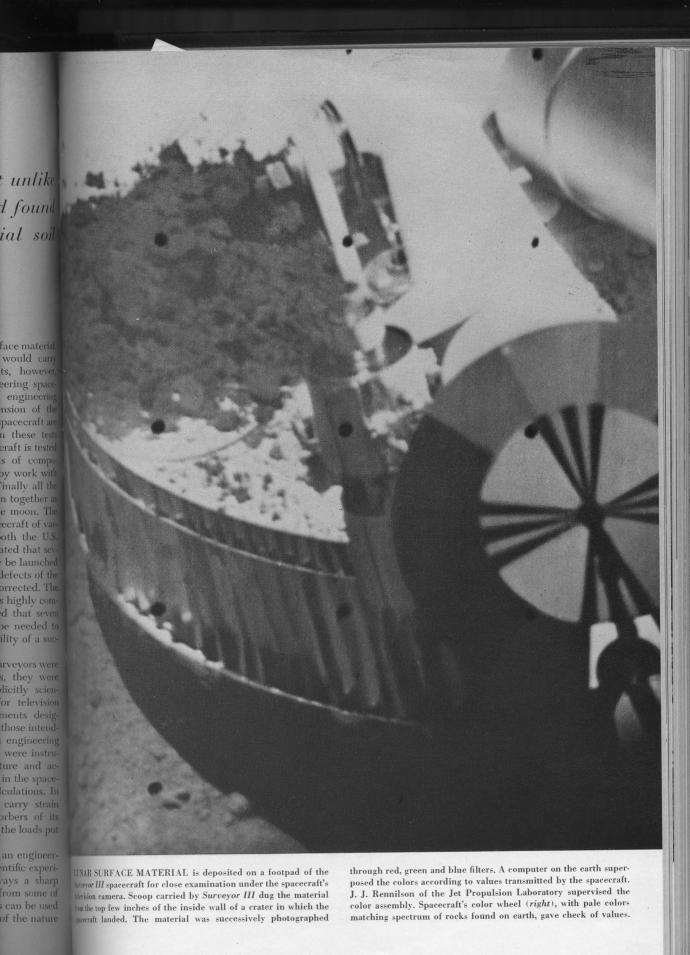
Scans from "The Feel of the Moon," Ronald F. Scott, Scientific American 217 no. 5 (November 1967), page 34.
“The Feel of the Moon,” an article written by Ronald F. Scott, was published in Scientific American in November of 1967, two years before Neil Armstrong walked on the moon. Scott asks, “When men first set foot on the moon, what will the ground be like?”1 Through various photographs taken by Surveyor I-VII—the space vehicles the United States sent to the moon to prepare for the initial Apollo flight—the author surmised how the moon’s surface might feel. In his attempt to convey the texture of something far away and unknown, Scott relied on the photograph’s flat surface (or, in some cases, still images from a telephoto lens attached to a television camera) and data collected by a Surveyor I-VII’s surface sampler, essentially a mini scoop that dips in and pulls back the surface of the moon for examination. “If the material is soft, the depth to which the scoop penetrates and the manner in which the soil deforms give a basis for interpretation of the nature of the surface. If the material is hard, the way in which it cracks or breaks when it is hit by the bucket is informative,” Scott wrote, explaining his analysis.2
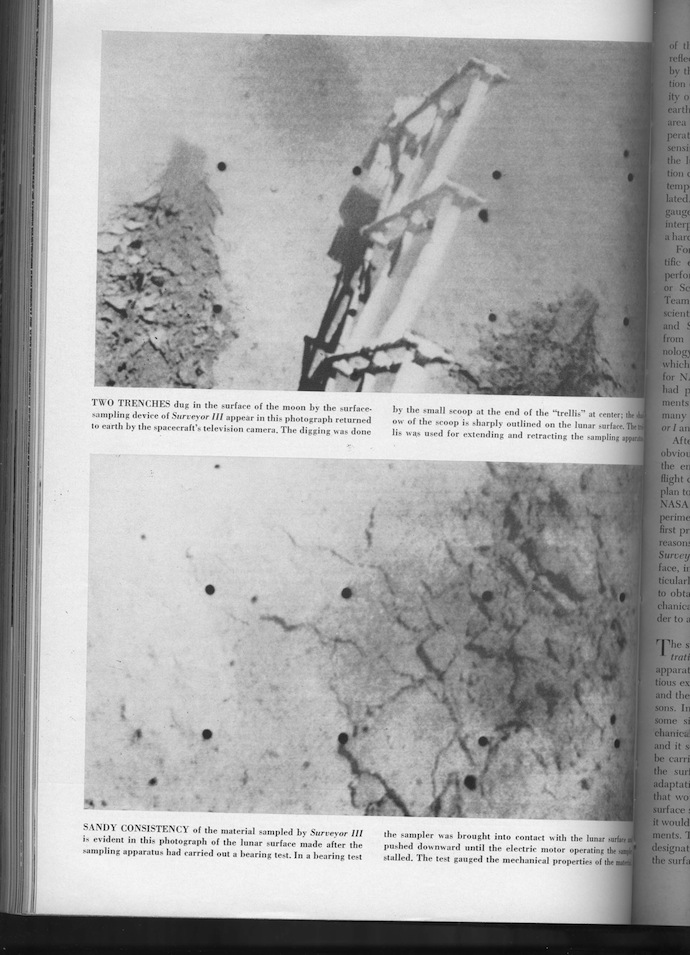
Scans from "The Feel of the Moon," Ronald F. Scott, Scientific American 217 no. 5 (November 1967), page 34.
Empirical information of the basic facts of the universe—what the moon feels like. How to understand that sensation when touch is impossible. That the flat surface photograph can denote that another surface is granular, like “loose soil.” Scott argued that a large portion of the grains have “a diameter of less than 30 microns,”3 coming to this conclusion based on a photograph of a mark left by the spacecraft’s two-bounce landing. That particular photograph is not included in the illustrations that accompany the article, which instead proffers images taken by the Surveyor I-VII that depict strange pockmarked sections of the moon. Made through the lens attached to the spacecraft, the photographs seem objective. Without a body behind the lens of this camera—it simply surveys and points—the photographs are more evidence than expression.
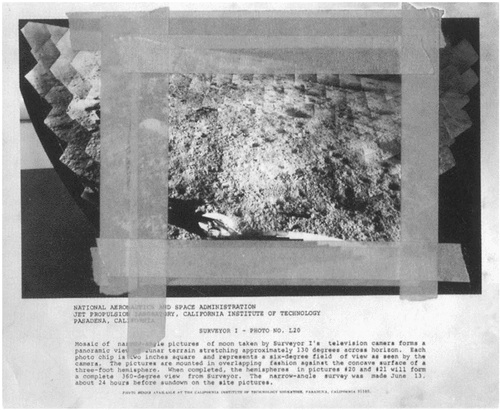
Vija Celmins, source photograph for Moon Surface (Surveyor 1), 1971-1972. Image courtesy the artist.
Vija Celmins liked the photographs in Scientific American. They were printed as a form of evidence, of factual information presented not as statistics but instead as what felt like verifiable representations of the world—the direct impression of the photograph. Celmins thumbed through the magazine, tore out images that attracted her and pocketed them for safekeeping. Many of these images pictured the lunar surface, particularly those taken by Surveyor I, the spacecraft that landed on June 2, 1966. In her interpretation of one of these images, Moon Surface (Surveyor 1) from 1971-72, Celmins used graphite in depicting the hazy photograph of the moon’s craggy surface. The drawing is slightly bleached out, as if the flash was too strong, and filled with uneven sections of light and dark. In the lower-left hand corner is a section of the spacecraft itself rendered in the palest grey.
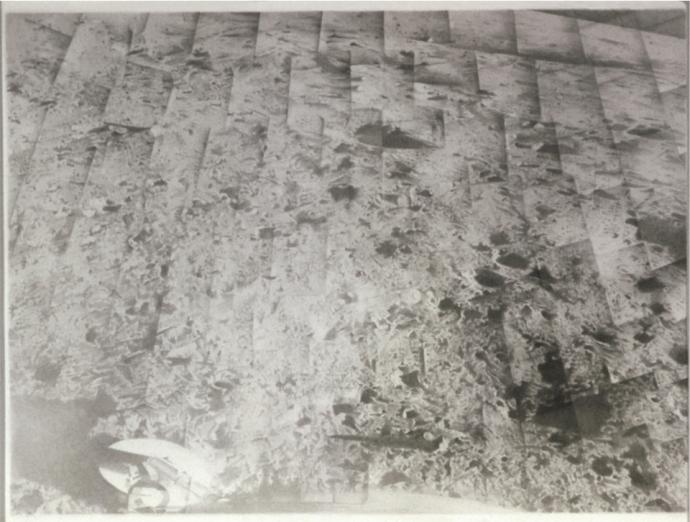
Vija Celmins, Moon Surface (Surveyor I), 1971-72; graphite on acrylic ground on paper; 14 x 18 1/2". Image courtesy the artist and McKee Gallery.
Celmins’s source photograph is a mosaic of pictures from Surveyor I that combined create a panoramic view of the moon. The final drawing is a study in surface, both Celmins’s—made out of graphite and its imprint on paper—as well as that cosmic surface whose feel could then only be imagined through photographs. “The paper is the skin and I put another skin on it,” Celmins explained, “To dig into the paper is gross.”4 A close looking informs both the photograph and the material of its remaking. Thus the work’s material properties become evident: a faint dusting of the graphite in one section, an inky black build-up in another. It is as if the picture of the photographs of the surface of the moon was a hand-crafted thing, a graphite-filled ground.
Celmins’s works are at once experiential in their engagement with material and wholly conceptual in her framing of the work. It is Celmins’s interest in scientific rendering that perhaps most markedly asserts her pictures of the natural world. “At the edges one breaks the illusion of continuous space and sees the making process and that the work is really a fiction,”5 she explained. In a sense, the action of translation feels scientific, even naturalistic. Or the reaffirmation of that-which-exists is only the natural world. The image doesn’t describe cosmic feeling, but instead, it transcribes the automatic camera lens controlled by an unmanned spacecraft.
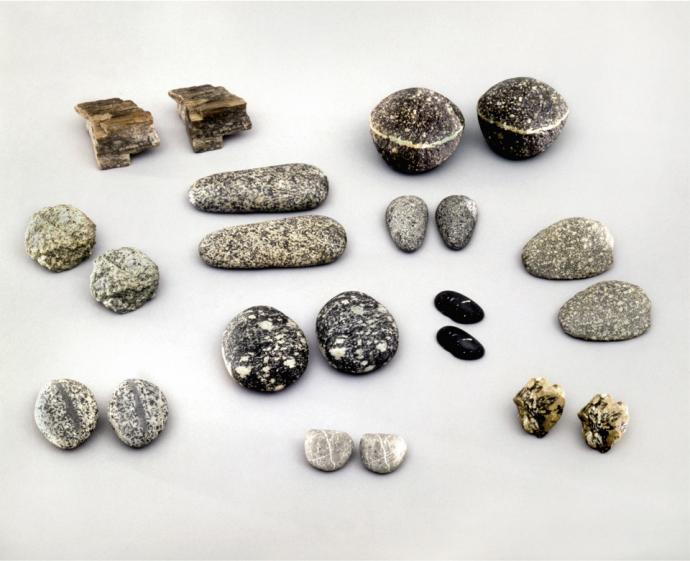
Vija Celmins, To Fix the Image in Memory I-XII, 1977-1982; collection of 11 stones and 11 painted bronzes. Image courtesy the artist and McKee Gallery.
What is the job of a naturalist but to look and to observe? Celmins provokes this kind of looking in her drawings of the surface of the moon. Nowhere is this more evident then in her project started in 1977, To Fix the Image in Memory I-XII, in which she took stones found on her walks in New Mexico and set about creating their identical matches out of bronze, paint and a steady hand. Mottled and stone-like, Celmin’s stones are not unlike her clipped out photographs from Scientific American; just as she tore out and pocketed her magazine images, she states that she found the stones on walks and then left them in her car for many months.6 Since she exhibits the found and the made stones together, they are simultaneously a presentation of the artist’s perceptual abilities and a testing of the viewer’s own abilities. It is a prompt to look very closely.
Celmins’s stones are self-reflexive; they confuse natural origin with man-made objects. And more than that, they ask the viewer to discern between the real and the made. It’s a destabilization of what we might refer to as natural, or, it’s a collapse in comparison. Celmins presents the everyday world to the viewer as a small, slow, made thing. A considered rendering of the common.
While it’s possible to find the profound in the ordinary, Celmins suspends that impulse in the guise of naturalism. To be a naturalist is to look for evidence, as Timothy Williamson explained in a recent editorial in the New York Times, to emphasize values such as “curiosity, honesty, accuracy, precision and rigor.”7 Naturalism as a dogma, an extreme, is dangerous, but Celmins approaches it as a kind of philosophical rendering of the world. For all of her specifics, the pinning of the picture to the page, imitating the spread of speckles on a stone just right, Celmins allows for the deeper meaning to remain wide open. Her work is the scanning of the photograph in a way not unlike the Surveyor’s scan of the moon; the arduous practice of deeply translating a thing made for concentrated looking.
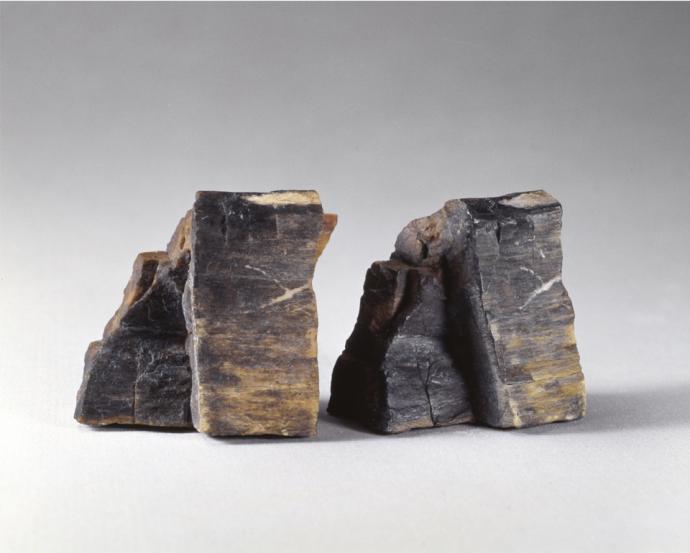
Vija Celmins, To Fix the Image in Memory I-XII (detail), 1977-1982; collection of 11 stones and 11 painted bronzes. Image courtesy the artist and McKee Gallery.
So what happens when examining a work by Celmins? Your eyes widen, you move in close and then back up. The graphite marks pull. Careful examination reflects both the viewer and Celmins, as if the spectator and artist were suspended, one to one, like the two stones placed next to one another. Almost all of her pictures are small in scale, and the stones are tiny as well. Just as Celmins sat alone in her studio in Venice Beach looking closely and moving her hand in accordance to her eye, we, the spectator, also see the image in a solitary moment. “In the case of the bronze stones, I wanted to see how much I could see; not to project any view, but to test my seeing and making, as if there were some secret to be discovered only there,” Celmins explained. “I left the original for the viewer to relive the process of seeing.”8 In the end, through the description of the information of the photograph sent from space or the small stones, the meaning is nestled somewhere in the time it took to create the work as well as the time it takes to look, “… as if the meaning of art was only in looking.”9 The process of discovering that meaning makes naturalists of us all.
- 1. Ronald F. Scott, “The Feel of the Moon,” Scientific American 217 no. 5 (November 1967), 34.
- 2. Ibid., 38.
- 3. Ibid., 42.
- 4. Vija Celmins, Vija Celmins: Dessins=Drawings, ed. Jonas Storsve (Paris: Centre Pompidou, 2006), 26.
- 5. Ibid., 26.
- 6. Author's interview with Celmins, August 2, 2011.
- 7. Timothy Williamson, “What is Naturalism?” New York Times, The Opinion Pages, September 4, 2011. http://opinionator.blogs.nytimes.com/2011/09/04/what-is-naturalism/
- 8. Close, Chuck. “Interview with Vija Celmins,” Vija Celmins (New York: Art Press, 1992), 20.
- 9. Ibid.